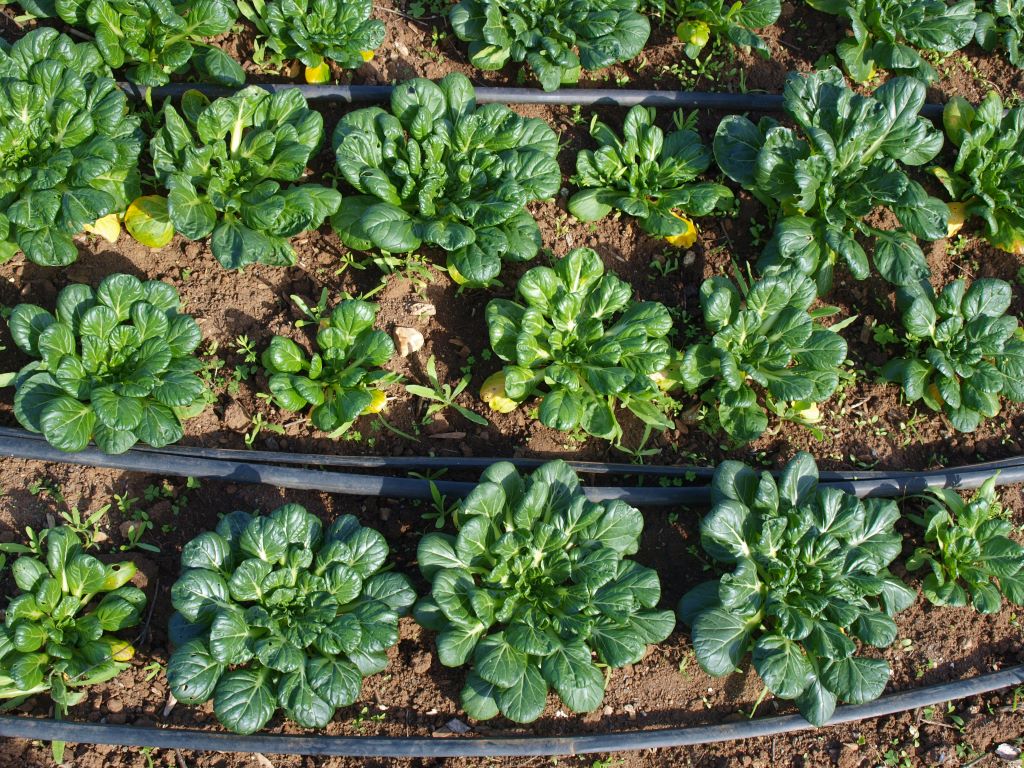Crop spacing
It is important that plants are spaced the right distance apart. Too far apart and space is wasted, too close together and they compete with each other. Every garden book and seed catalog tells you how far apart to plant the various vegetable crops (and this one is no different). These recommended spacings are useful relative to one another, but they may be altered by a number of factors.
• The most important factor is soil fertility. The better the soil, the more nutrients are readily available and the closer you can space your plants. In the rich deep soil of an intensive bed, roots can go straight down in search of nutrients. This means they don’t need to compete with neighboring plants by sending out side roots. Consequently you can put the plants closer together than you could in a row garden.
• In poor soil you must space the plants further apart, to ensure that each plant has enough volume of soil in which to forage for nutrients.
• Competition for light is a major factor affecting plant growth. If plants are too close together they eventually start to compete for light and growth will be impaired for all of them. It is obvious when this is happening, because the plants grow tall and leggy and often fall over.
• Another problem when plants are too close together is poor air circulation. This encourages high humidity and in wet climates can increase the potential for disease.
• Plants can be spaced more closely together in winter, as they grow more slowly and don’t get as large. The closer spacing promotes the earlier formation of a microclimate and means less area to cover with cloches or row covers.
• Water isn’t usually a limiting factor in intensive beds, because its fairly easy to replace that consumed. However in arid areas where water is scarce, water becomes as valuable as any other nutrient. You then have to space plants further apart, to ensure each individual has enough volume of soil in which to forage for water, without having to compete with neighbors. In the arid southwest native Americans sometimes planted their corn 6 feet apart each way.
If your soil is very weedy, you might want to space the plants far enough apart, so you can get a hoe between them easily.
The variety used may also affect spacing, some are more compact and can be spaced closer together.
Finding the right spacing
Ideally crops should be planted so their foliage barely touches when they are mature. This creates a cool moist microclimate around the plants that inhibits moisture evaporation and is very conducive to good growth. If plants are closer together than this, they inhibit each other. If they are further apart space is wasted and you don’t get the microclimate effect.
Every situation has an optimal spacing, depending upon soil fertility, climate, variety and crop. The obvious way to determine the optimal spacing for a crop, would be to experiment with growing it at many different spacings and see what happens.
Spacing can be varied to affect the size of the crop part. For example a closer spacing results in smaller onion bulbs or broccoli heads, than a wider spacing.
Spacing also has a direct effect on the total harvest. Very widely spaced plants produce very large individual plants, but give a low total yield for a given area, because there are so few plants. Closer spacing increases yield because there are more plants in the area. At a certain point the size of the individual plant starts to go down slightly, but because there are more plants in the area the yield continues to rise. Finally you reach a point where so many individual plants are packed into the area that they start to inhibit each other and yield declines.
Problems with close spacing
Intensive gardening books often emphasize how close you can space crops with their methods, but very close spacing requires exceptionally fertile soil. If you don’t have such soil then you need to give your plants enough room.
If you have ever put plants too close together you will be familiar with the result. They look great while they are small, but eventually start to compete with each other and get tall and leggy. Water on the leaves makes them top heavy and they may be blown over by the wind. Overcrowding can also cause nutrient deficiencies as roots compete for nutrients. In humid areas the poor air circulation around the leaves may encourages disease. If you are lucky you might get a harvest from such plants, but usually not very much.
Planting options
The spacing you use for a crop will determine how big the final harvest will be. There are several options:
• You might choose to grow a maximum number of full size plants, and sacrifice some yield, by spacing them quite far apart. This was how traditional row spacing worked, giving large individual plants, but wasting a lot of space. As a consequence the yield per square foot was relatively low. Plants that need lots of space include the Cucurbits (sprawling or bushy), tomatoes (prone to disease if they don’t get good air circulation) and Brussels sprouts (need a lot of light to mature properly).
• To get the maximum harvest of full size plants, put them in offset rows, close enough together that they actually touch when they reach full size. This will give you the maximum number of full size plants for the area.
• The way to get the biggest harvest of all is to make do with slightly smaller mature plants, but have a lot more of them. You do this by planting them closer together, as I have just described. Some plants lend themselves to very close spacings by their shape and growth habits, such as onion, leek, garlic, celery and carrot .
• The ultimate in close spacing is growing salad greens for individual leaves.
• In winter plants don’t get as big as they would in warmer weather and so can be planted somewhat closer together.
Ridiculously close spacing
The closest spacing in vegetable gardening is used for growing cut and come again salad mix, where we aim to sow seeds only a half inch apart. This works because we don’t expect or want the plants to grow very large. In fact we rely on the competition from close spacing to keep the size of each plant quite uniform, which is what we want when we are only harvesting individual leaves.
Spacing pattern
Spacing isn’t just about the distance between individual plants, it is also about their arrangement relative to one another. One of the keys to maximizing productivity is to space the plants equidistantly over the soil, so they can take advantage of all of the available sunlight, water and nutrients and to minimize competition between individuals. This is in contrast with row crops, where plants are often crowded on two sides and have more space than they need on the other two.
When thinking about spacing the important measurement isn’t the distance between the stems of the plants, but rather the space the plant fills, which is a circle. By offsetting the circles (plants) you can plant closer together and so make the most of limited space. Rows only need to be 5˝ apart to get the desired 6˝ spacing between individuals.
Planting in offset rows has an additional benefit of making hoeing easier. You simply run the hoe diagonally across the bed, between the rows of young plants, in both directions.
Not all crops lend themselves to equidistant spacing, some do better, or are more conveniently grown, in rows or hills. Climbing vines are most easily supported if grown in rows down the bed. Very large crops may take up almost the whole width of the bed.
Keeping consistent spacing
Once you have decided upon the ideal spacing you must use it. This means spacing the plants consistently in the bed. It’s no good deciding that a 9˝ spacing is optimal and then setting out your plants at varying distances from 6 – 12˝ (it’s happens frequently).
There are several ways to ensure you get the right spacing and stay with it. You could measure the length of your trowel or hand (measure the lengths to different points), or make a pre-measured stick (break it off to the right length). You might also make a ruler from an eight foot length of 1˝ x 3˝, marking off the required lengths. You then simply lay the ruler alongside the bed and put in plants at the right measurement. Some people make triangles or other jigs to ensure they get the right spacing. Once you get good at planting you will probably space the plants by eye, as it’s faster and you don’t need any special tools.
Wasted space on two sides
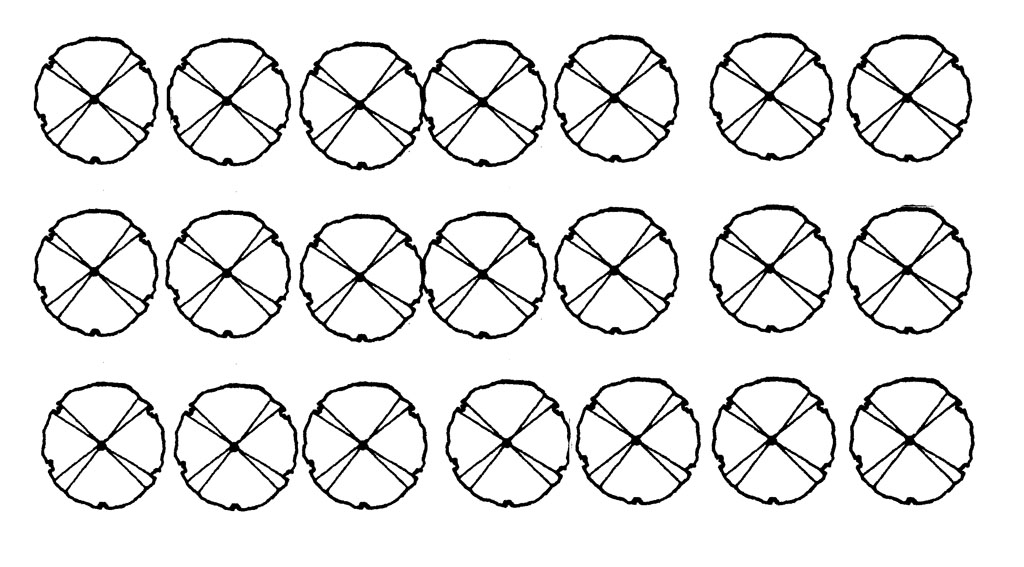
A more efficient arrangement
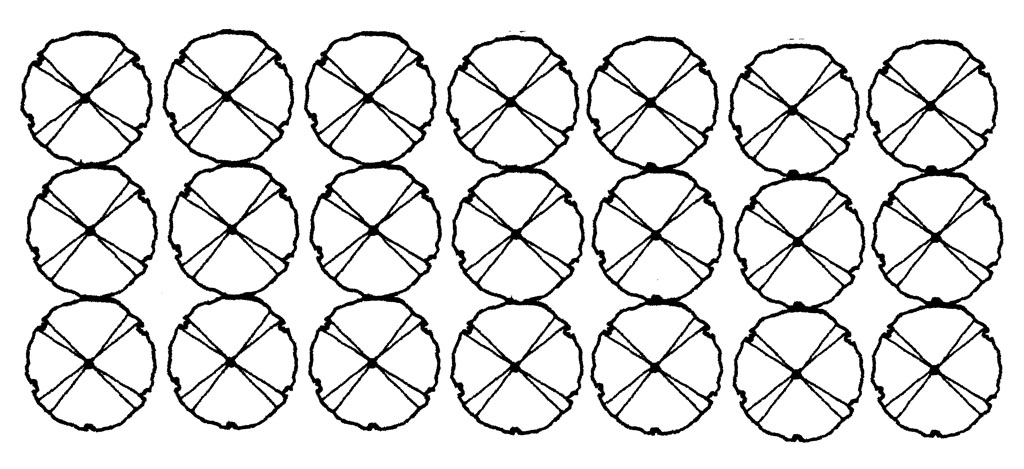
Offset rows are the most efficient way to space plants
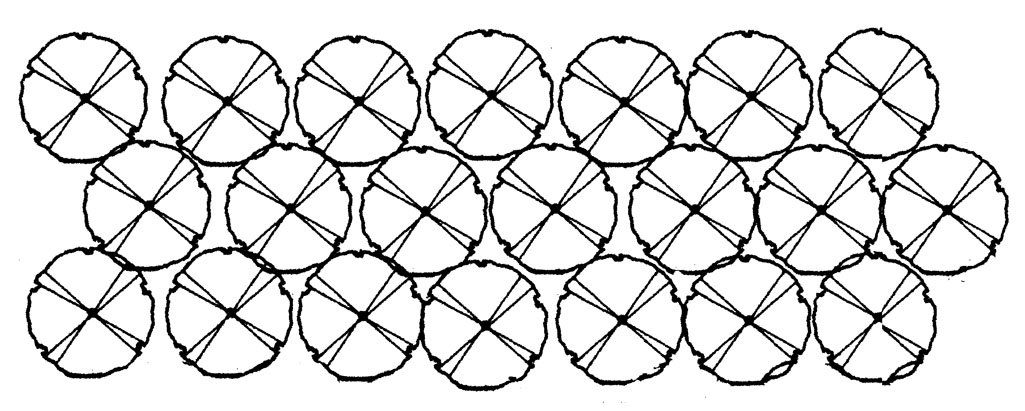
Wider spacing for easier hoeing
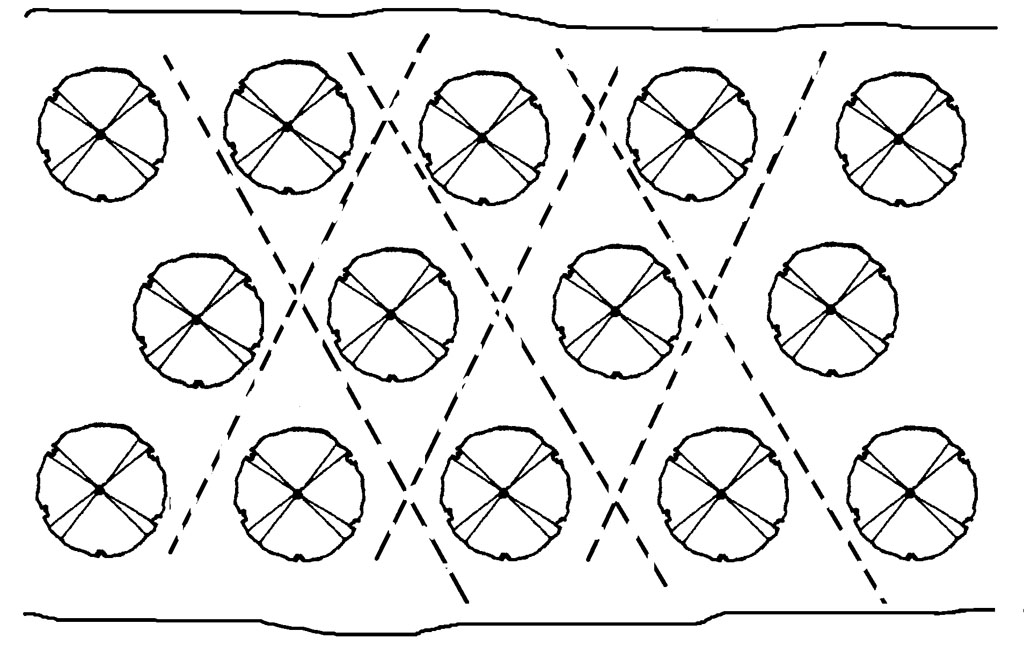
Crop spacing chart
Spacing recommendations may be altered by many factors, but it helps to have some guideline, so here is my chart.
| Crop | Poor soil | Average soil | Rich soil | Rows | |
| Amaranth, Grain | 18 | 15 | 12 | 12 x 30 | |
| Amaranth, Leaf | 8˝ | 6˝ | 4˝ | 6 x 18 | |
| Artichoke, Globe | 72˝ | 36 x 60 | |||
| Arugala | 8 | 6 | 4 | ||
| Asparagus | 24˝ | 18˝ | 12˝ | 24 x 60 | |
| Basil | 8˝ | 6˝ | 4˝ | ||
| Bean, Bush | 6˝ | 4˝ | 3˝ | 4˝ x 18˝ | |
| Bean, Fava | 12˝ | 8˝ | 6˝ | 4˝ x 18˝ | |
| Bean, Pole | 8˝ | 6˝ | 4˝ | 3 x 18 | |
| Bean, Lima | 10˝ | 8˝ | 6˝ | 4 x 24 | |
| Bean, Scarlet Runner | 15˝ | 12˝ | 9˝ | 6 x 18 | |
| Bean, Soy | 8 | 6 | 4 | 4 x 18 | |
| Beet | 6˝ | 4˝ | 3˝ | ||
| Bok Choy / Pak Choy | 8 | 6 | 4 | ||
| Broccoli | 18˝ | 15˝ | 12˝ | 12 x 36 | |
| Brussels sprout | 30˝ | 25˝ | 20˝ | 18 x 38 | |
| Buckwheat | 8 | 6 | 4 | ||
| Cabbage, Head | 18˝ | 15˝ | 12˝ | 12 x 24 | |
| Cabbage, Leaf | 8˝ | 6˝ | 4˝ | 3˝ x 15˝ | |
| Carrot | 5˝ | 3˝ | 1.5˝ | 3 x 18 | |
| Cauliflower | 24˝ | 21˝ | 18˝ | 15 x 24 | |
| Celeriac | 15 | 12 | 10 | 8 x 18 | |
| Celery | 12˝ | 9˝ | 6˝ | 8 x 18 | |
| Chard | 12˝ | 8˝ | 6˝ | 8 x 24 | |
| Chicory | 12˝ | 10˝ | 8˝ | ||
| Chickpea | 6 | 5 | 4 | 3 x 18 | |
| Cilantro | 8 | 6 | 4 | 6 x 18 | |
| Corn | 18˝ | 15˝ | 12˝ | 6 x 24 | |
| Cucumber | 24˝ | 18˝ | 12˝ | 12˝x 36˝ | |
| Eggplant | 24˝ | 18˝ | 15˝ | 18 x 24 | |
| Garlic | 10˝ | 8˝ | 6˝ | 3˝ x 12˝ | |
| Hamburg Parsley | 6 | 4 | 3 | 4 x 18 |
| Kale | 18˝ | 15˝ | 12˝ | 12 x 18 | |
| Kohlrabi | 12˝ | 6˝ | 4˝ | 4 x 18 | |
| Leek | 12˝ | 9˝ | 6˝ | 5˝ x 12˝ | |
| Lettuce, Head | 15˝ | 12˝ | 9˝ | ||
| Lettuce, Leaf | 12˝ | 8˝ | 6˝ | ||
| Melon | 24˝ | 18˝ | 15˝ | 24 x 60 | |
| Mustard | 8˝ | 6˝ | 4˝ | 4 x 18 | |
| Okra | 18 | 15 | 12 | 12 x 30 | |
| Onion, Bulb | 6˝ | 4˝ | 2.5˝ | 2˝ x 8˝ | |
| Onion, Welsh | 4˝ | 2.5˝ | 1˝ | 1˝ x 6˝ | |
| Parsley | 6˝ | 4˝ | 3˝ | 2˝ x 10˝ | |
| Parsnip | 5˝ | 4˝ | 3˝ | 2˝ x 12˝ | |
| Pea, Bush | 5˝ | 4˝ | 3˝ | 3 x 24 | |
| Pea, Pole | 5˝ | 4˝ | 3˝ | 3 x 24 | |
| Peanut | 12 | 10 | 8 | 6 x 20 | |
| Pepper | 24˝ | 18˝ | 12˝ | 12 x 30 | |
| Potato | 16˝ | 12˝ | 9˝ | 12 x 24 | |
| Quinoa | 18 | 12 | 8 | 6 x 24 | |
| Radish | 4˝ | 2˝ | 1˝ | 1˝ x 4˝ | |
| Shallot | 8˝ | 6˝ | 4˝ | 4 x 9 | |
| Spinach | 8˝ | 6˝ | 4˝ | 4 x 12 | |
| Squash, Summer | 30˝ | 24˝ | 18˝ | 18 x 48 | |
| Squash, Winter and Pumpkin | 36˝ | 30˝ | 24˝ | 24 x 48 | |
| Sweet Potato | 18 | 15 | 12 | 12 x 36 | |
| Tomatillo | 36 | 24 | 18 | 24 x 36 | |
| Tomato | 30˝ | 24˝ | 18˝ | 18 x 36 | |
| Turnip | 8˝ | 5˝ | 3˝ | 3˝ x 10˝ |











